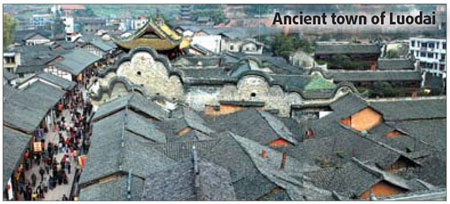
|
LIFE> Travel
 |
|
Friendship blossoms between Sichuan and Georgia
By Huang Zhiling, Chen Liang, Wang Wei (China Daily)
Updated: 2008-08-21 15:17 After finishing their performance in Luodai, an ancient town of about 20,000 Hakka people in the Longquanyi district of Chengdu, capital of Sichuan province, a troupe of American performers passed a square where they saw 2,000 local residents dancing to keep fit. "The American performers were moved by the peaceful lifestyle of the locals and got off their bus to mingle with them, singing and dancing," Liu Bin, an information officer in the Longquanyi district, told China Daily. Only 18 km east of the city, Luodai is a Hakka town of unique historical and cultural interest. The Hakkas are a branch of the Han Chinese. From north and central China, Hakka people first moved to south China's Guangdong province and east China's Fujian province to escape persecution and their name reflects their past - Hakka means "guests." Today their communities are scattered across southeast Asia. In the early years of the Qing Dynasty (1644-1911), the Hakkas began moving to Sichuan from the provinces of Guangdong, Hubei, Hunan and Jiangxi. More than 2 million descendants of the Hakkas now live in Sichuan. Many of them live in five towns at the foot of the Longquan Mountains east of Chengdu. Luodai is the largest of the towns. More than 20,000 of its 23,000 residents are descendants of the Hakka. The town has a strong ambience of their culture and locals speak both Hakka and Chengdu dialects. The old town has only one street. Most of its buildings are scattered along a road paved with stone. Flat and low, with black-tiled roofs, white walls and wooden doors, its buildings are all in the traditional style commonly found in any country town in Sichuan. The street is lined with teahouses and liquor shops with big vats of strong alcohol.
 Sister counties Longquanyi is famous for its peach blossoms in spring. Since 1987, it has held a peach blossom festival every year. But this year's was truly international due to the participation of Peach County, Georgia in the United States. Known as one of China's top-four fruit producing centers, Longquanyi grows 170 types of fruit, but has one big thing in common with Peach County - prunus persica, better known as the peach. Both Longquanyi and Peach County are located at 30 degrees north latitude. Areas along that line are generally ideal for growing peaches, Liu Bin said. Covering 33 sq km, Longquanyi has been cultivating the fruit for about 3,000 years. It has 17 million peach trees. In fact Georgia's signature crop originated in Longquanyi. In 1875 an American priest visited Longquanyi and returned to Georgia with 30 peach seeds and 10 peach seedlings to help revitalize the state's economy, which was devastated by the American Civil War. Peaches became a prime agricultural product of Georgia. Of course Peach County got its name from the thriving fruit. While Longquanyi hosts a peach blossom festival each spring, Peach County has held an annual peach festival since 1986. Last September, Song Yang, a native of Chengdu and vice chairman of the US-China Cultural and Educational Foundation in Atlanta, capital of Georgia, made a proposal to Peach County Commission Chairman James Khoury to link the peach blossom festivals of Chengdu and Peach County. He proposed a sister county relationship to hold both cultural and agricultural exchanges. From March 19 to 23 Khoury led a 37-member delegation to Chengdu. They signed a sister county agreement with the Longquanyi district government on March 22. Sea of flowers Beginning in mid-March each year, Longquanyi, only 14 km from downtown Chengdu, turns into a sea of delicate pink peach flowers. Each spring, more than 1 million tourists attend the peach blossom festival. "Last year, the district received more than 3.3 million visitor-days and earned more than 600 million yuan in tourism earnings," Liu said. Georgia ranks 3rd in the US in production of peaches, with more than 15,000 acres of trees yielding over 1.7 million bushels of peaches annually. More than half of that harvest is cultivated in Peach County alone, Bennett said. The Georgia Peach Festival attracts between 7,000 and 15,000 visitors during festival week, he said. |